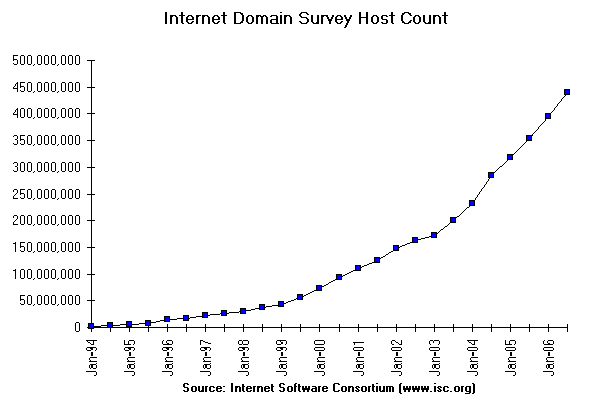
This graph shows changes in host count. Simply put, host count means the number of computers connected to the Internet. The number already exceeded 450 million worldwide in 2006.
This graph is extracted from http://www.isc.org. For the latest information, visit http://www.isc.org/ds/hosts.html.
So who takes control of this huge network connecting as many as 450 million computers together? As a matter of fact, no one does. It is neither managed by the United States nor some large corporation.
The Internet is called ga softly-united bodyh. Although no organization controls its whole system, there are many gcoordinating bodiesh represented by the following:
These coordinating bodies are responsible for standardization of the technology used on the Internet. Standardization makes it possible to exchange e-mail and visit websites on a global scale. You can learn more about standardization in the next section.
The Internet is a highly public system, but since it is a gsoftly-united bodyh with no overall supervisor, each user needs to make proper use of the network based on their moral consciousness.
To make communications valid on the Internet, standardization is indispensable. The Internet Architecture Board (IAB), the advisory body of the Internet Society (ISOC), is responsible for creating Internet standards. Here is a simple example to explain standardization.
Suppose there are two persons - one of them is me, a Japanese who understands only Japanese, and another a German who understands only German. We can hear each other, but have no means of communication. In order to understand each other, it is necessary:
We need to have a lingua franca for mutual communication. This is where gstandardizationh comes in.
If we apply this to telecommunications, just connecting two computers by power cables doesn't enable mutual correspondence. Without a common signal that both computers can understand, we can't exchange e-mails that make sense to both of us, browse websites and transfer files. There needs to be a decision about what signal to use and by what rules. This agreement in the world of telecommunications is called "protocol". Its original meaning is "diplomatic procedure", but in the field of telecommunications, it means a set of rules governing the exchange or transmission of data.
Here is some information on the management of the network inside Meiji University. Our network is operated under the following system.